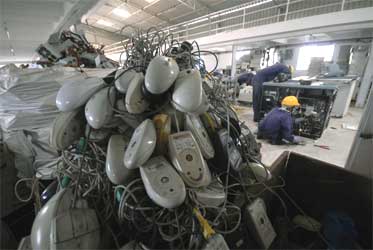 | « Back to article | Print this article |
India's IT leaves its worst year behind
India's export-oriented software industry has put behind it the toughest year in its history, with its business model intact.
The recovery now under way is likely to be broad-based, stretching across geographies, businesses and verticals, according to Wipro chairman Azim Premji, who is the industry doyen.
This is why the stock market's response to the fourth quarter results has been guided more by the forecasts issued, as in the case of Infosys, than by the performance in the last quarter.
The expected recovery is likely to walk on two legs.
Click NEXT to read further. . .
India's IT leaves its worst year behind
One is the recovery of the global financial majors who are critical to Indian software for being among its largest customers.
The other is the incipient overall recovery in the mature economies which is expected to enable firms to again start spending for greater efficiencies.
The anticipation of good times ahead is indicated by projections of higher hiring and announcement of pay hikes.
Among the industry leaders, by far the best performance this past year has been by Tata Consultancy Services, which has achieved 17 per cent volume growth in a year of recession.
Click NEXT to read further. . .
India's IT leaves its worst year behind
But the even more remarkable feat has been the improvement in its margins.
From being behind margin leader Infosys by 10 percentage points in the beginning of the year, it has closed the fourth quarter just 1 percentage point behind.
That is why CEO N Chandrasekaran has described 2009-10 as an exceptional year in which the company has been able to build a solid platform for growth.
His optimism is based partly on the prospect of getting large orders, the first in the line being a likely $100 million deal with Deutsche Bank to install core banking solutions for its operations in 52 countries.
Click NEXT to read further. . .
India's IT leaves its worst year behind
Against this, while Infosys' top line performance has been subdued, Wipro's, with its non-IT businesses, has fluctuated sharply between positive and negative territory. In the last quarter, margins for both Infosys and Wipro had shrunk slightly.
The key question is whether the industry will go back to exceptional growth as global recovery takes root over the next two to three years, or settle down to a sedate pace in comparison to its own chequered past.
The National Association of Software and Services Companies, industry lobby group, has projected a compounded annual growth rate for the new decade of no more than 13-14 per cent, or no faster than the expected growth in nominal gross domestic product.
Click NEXT to read further. . .
India's IT leaves its worst year behind
This would seem to be unduly modest, and overly influenced by the challenges of the past couple of years.
Industry leaders talk privately of aiming for sustained growth of 20 per cent. The good news is that even domestic IT expenditure is going up rapidly, propelled by rising government spending.
This is likely to give a top line boost to the industry, though domestic margins are lower than in mature markets.
Meanwhile, the rupee's rising exchange value has already dampened performance. However, since further rupee appreciation is likely to be limited, the potential downside on this count is small.





